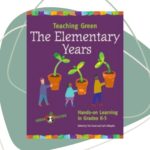Description
Reviews
Read the introduction
View the table of contents
Tim Grant and Gail Littlejohn (editors)
Greening School Grounds: Creating Habitats for Learning, Toronto: Green Teacher, 2001 first edition
ISBN 978-0-86571-436-6, 136 pages, Grades K-12.
Schoolyard “greening” is an excellent way to promote hands-on, interdisciplinary learning through projects that benefit schools and increase green space and biodiversity in communities. In this popular anthology from Green Teacher magazine, readers will find step-by-step instructions for numerous schoolyard projects, from tree nurseries to school composting to native plant gardens, along with ideas for enhancing learning by addressing the diverse needs of students. Among more than a dozen schoolyard habitat options presented, the guide includes detailed articles on rooftop gardens, far-north gardens, desert gardens, butterfly gardens, ponds and prairie restorations. For project planners, there are practical tips on minimizing vandalism, maximizing participation and raising funds. And for teachers, there are dozens of outdoor classroom activities and curriculum links, a bibliography of learning resources, and up-to-date listings of funders and training organizations. Greening School Grounds is a compendium of the best schoolyard greening articles and activities from Green Teacher.
Contact info@greenteacher.com for more information
What people are saying …
“This comprehensive resource draws on expertise from across the continent to provide all the information you’ll need to jump into a schoolyard naturalization project of your own. Grab the paper and pencils and start planning!” – Barbara McKean, Public Programs Coordinator, Royal Botanical Gardens, Hamilton, Ontario, and author of several books on wildlife and wildflowers.
“If you are greening a school, Greening School Grounds is an essential reference. It is wide ranging, readable and realistic.” – Mary Rivkin, Associate Professor of Education, University of Maryland, Baltimore County, and author of The Great Outdoors: Restoring Children’s Right to Play Outside.
“Greening School Grounds prepares teachers to take full advantage of their schoolyards by offering advice from successful habitats for learning around North America.” – David Wicks, Coordinator, Center for Environmental Education, Jefferson County Public Schools, Louisville, Kentucky and Year 2000 President, North American Association for Environmental Education.
“A must have for any educator’s bookshelf.” – Cheryl Dixon, Education Coordinator of the National Wildlife Federation, Northwest Natural Resource Center, Seattle, Washington.
Introduction
by Tim Grant and Gail Littlejohn
Pedagogical theories come and go, but everywhere and always it is innovative and energetic teachers who are the real ground breakers in education. Never has this been more literally true than during the past few years as teachers and students across North America have begun to break ground for greener schoolyards. Tilling the soil, planting a seed, creating a nature trail, feeding the birds — it all seems slightly anachronistic at a time when the real, serious purpose of education, we hear, is to prepare young people to compete in a high-tech, global economy. Of course the real purposes of education are both broader and deeper than this, and as many writers in this collection point out, a great many of them can be met in an outdoor classroom This book is not a dig-it-and-seed-it planting guide for schoolyard sodbusters, although it does offer much practical how-to advice. Rather, its aim is to guide teachers through all phases of a school grounds project, from developing a rationale that will win the support of principals and administrators, through redesigning the grounds, to tapping the rich potential of the schoolyard as a place for hands-on, multidisciplinary learning. The organization of the book mirrors this process. The Perspectives section helps readers develop a cogent argument for undertaking a school greening project; it does so, in part, by pointing to research that overwhelmingly supports the view that such projects offer substantial intellectual, emotional and social benefits to children. The Getting Started section gives advice on organizing a project team, developing a collective vision, and getting the support of volunteers and funders. The middle three sections form the heart of planning and implementation, offering design suggestions and how-to advice on a variety of projects from natural wetlands to butterfly gardens to tree nurseries. Finally, the largest section of the book, Learning in the Outdoor Classroom, is devoted to the myriad and multifaceted educational uses of a school nature area. As a whole, the book reflects the expertise of more than 40 authors and 75 reviewers, many of them North American pioneers in schoolyard greening. As one might expect, their ideas are creative and often ambitious. Yet any project that aims to beautify and diversify a beast as big and bleak as the average schoolyard will take time, energy, enthusiasm, and usually money — in other words, all the personal resources that tend to run dangerously low on Friday afternoons. That is why, again and again throughout the planning of this book, the voices of the experienced have urged and reminded us to “tell teachers to start small.” And so we do, hoping that this book will inspire grand plans but at the same time provide the direction and tools to begin the journey in small, manageable steps. No matter how modestly you begin, you will be enriching young people’s lives, strengthening your community, and adding your vision and voice to the most vibrant educational movement currently underway on this continent.
Table of Contents
Acknowledgements
Introduction
Perspectives
Transforming School Grounds by Ann Coffey
How Schoolyards Influence Behavior by Edward Cheskey The Pedagogical Potential of School Grounds by Anne Bell
Sowing a School Garden: Reaping an Environmental Ethic by Janet Pivnick
Getting Started
Maximizing Participation: Go Team! by Stephanie Stowell
Funding Schoolyard Projects by Marilyn C.Wyzga
Ugliest School Yard Contest by Tim Grant and Gail Littlejohn
A Step-by-step Planning Guide by Miriam Mutton and Debbie Smith
School Grounds in a Box: Model-making and Design by Ann Coffey
Greening High Schools: Leaping Subject Barriers by Barbara Kerby and John Egana
Greening the Grounds
A Diverse Dozen: Habitats for Healthy School Ground by Paul E. Knoop
Rethinking Tree Planting by Henry Kock Natural Wetlands and Retention Ponds by Jackie Oblak
Bringing Back the Prairie: Ecological Restoration by Molly Fifield Murray
Desert and Dryland Gardens by Janet Fox
Creating a Schoolyard Tree Nursery by Cathy Dueck Rooftop Gardens by Monica Kuhn
Attracting Wildlife
Whatever Happened to the `Wild’ in Kids’ Lives? by Edward Cheskey
The Foundation of Habitat: Native Plants by David Mizejewski
Amphibian Oasis by Heather Gosselin and Bob Johnson
Avian Attraction by Ken Quanz and Edward Cheskey
Projects for the Birds by Steven Uriarte Butterfly Gardens by Kim Denman
Enhancements and Safety
Benches, Bridges and Other Beautiful Things by Gary Pennington
Sun Shelters: Respite from the Rays by Drew Monkman
Schoolyard Ponds: Safety and Liability by Sharon Gamson Danks
Discouraging Vandalism in Schoolyard Habitats by Beth Stout \
Composting at School by Rhea Dawn Mahar
Learning in the Outdoor Classroom
The Panther Patch: A K-6 Gardening Plan by Janice Hanscom and Felicia Leipzig
Creating a Field Guide to Your Nature Area by Bruce R. Dean
Learning Links for Elementary Classes by Jeff Reading and George Taven
K-12 Activities for the Outdoor Classroom by Char Bezanson, Craig Johnson, Bill Lindquist and Nalani McCutcheon
K-12 Learning in a Schoolyard Prairie by Robin Greenler
The Abundance of Nature’s Imagination by Karen Krupa
Math in the Schoolyard by Char Bezanson and Judy Killion
Exploring Food and Culture through Gardening by Nicole Thibault
Tips and Tricks for Taking Kids Outside by Nalani McCutcheon and Andrea Swanson
Service Learning: Connecting Classrooms with Communities by Mary Haque
Project Support and Resources Index Curriculum Index










